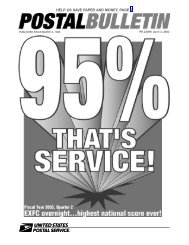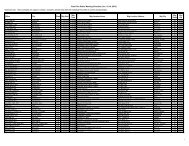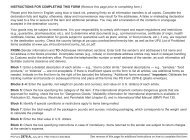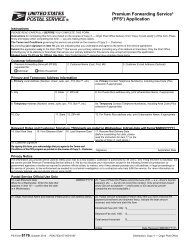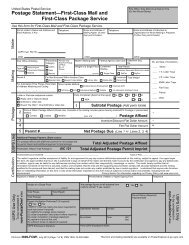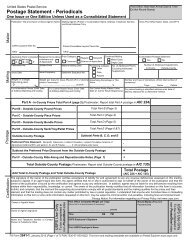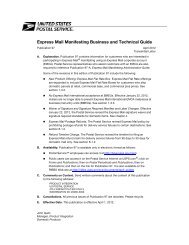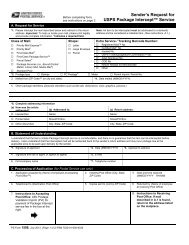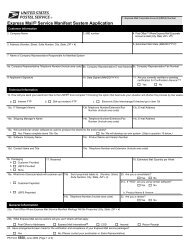Postal Bulletin 22144 - December 23, 2004 - USPS.com
Postal Bulletin 22144 - December 23, 2004 - USPS.com
Postal Bulletin 22144 - December 23, 2004 - USPS.com
You also want an ePaper? Increase the reach of your titles
YUMPU automatically turns print PDFs into web optimized ePapers that Google loves.
POSTAL BULLETIN <strong>22144</strong> (12-<strong>23</strong>-04)<br />
3<br />
<strong>USPS</strong>NEWS@WORK<br />
NAPS President Vincent Palladino dies:<br />
Longtime NAPS officer was in his 13 th<br />
year as president<br />
National Association of <strong>Postal</strong> Supervisors (NAPS)<br />
President Vincent Palladino died unexpectedly at his<br />
Arlington, VA, home yesterday. He was 69. Palladino was<br />
elected to his seventh consecutive two-year term as president<br />
of NAPS at the organization’s 59th national convention<br />
in Kansas City, MO, in August.<br />
Calling Palladino a close friend and ardent advocate for<br />
his membership and the <strong>Postal</strong> Service, PMG Jack Potter<br />
said Palladino represented NAPS members well.<br />
“I also knew that when I needed an informal opinion on<br />
postal issues, I could always turn to Vince. I valued his experience,<br />
perspectives and candor,” Potter said. “He was<br />
devoted to his family, a mentor to many and a friend to all.”<br />
“Vince Palladino’s passing is a loss not only to NAPS,<br />
but to the entire postal <strong>com</strong>munity,” said NAPS Executive<br />
Vice President Ted Keating, who assumes the NAPS presidency.<br />
“Vince possessed a keen insight into the problems<br />
facing the <strong>Postal</strong> Service and didn’t hesitate to voice his<br />
opinion on how they might be addressed.”<br />
Palladino represented more than 35,000 active and retired<br />
postal supervisors, managers and postmasters. Before<br />
being elected NAPS president in 1992, he served as<br />
the organization’s executive vice president for six years. He<br />
testified before the President’s Commission on the U.S.<br />
<strong>Postal</strong> Service in 2003, suggesting new ways the <strong>Postal</strong><br />
Service could operate and still bring in money.<br />
Palladino began his career as a letter carrier in Staten<br />
Island, NY, in 1960. He was later promoted to foreman of<br />
mails and then station manager in 1970. Prior to joining the<br />
<strong>Postal</strong> Service, Palladino served in the U.S. Air Force for<br />
four years.<br />
FY ’04 a fiscal success: Surplus<br />
revenues tempered by shifting mail<br />
volumes<br />
The Transformation Plan is working.<br />
That’s the word from the Board of Governors year-end<br />
meeting, where it was reported the <strong>Postal</strong> Service achieved<br />
a surplus for the second consecutive fiscal year, with a net<br />
in<strong>com</strong>e of $3.1 billion on revenues of $69 billion.<br />
Postmaster General Potter said we’ve achieved <strong>USPS</strong><br />
business goals in <strong>2004</strong> to improve service, reduce costs<br />
and continue to build our business.<br />
The good news was tempered by <strong>com</strong>ments that marketplace<br />
forces are changing the character of the mail and<br />
could threaten <strong>Postal</strong> Service financial viability in future<br />
years with First-Class Mail pieces projected to fall below<br />
Standard Mail pieces as the largest volume product. Chief<br />
Financial Officer Richard Strasser said this shift in mail mix<br />
to lower revenue-per-piece mail classes will result in shrinking<br />
margins which are used to maintain universal service.<br />
Strasser told the Board that total revenue reached $69<br />
billion — an increase of $265 million over last year. First-<br />
Class Mail service brought in revenue of $36.4 billion, Standard<br />
Mail service, $18.1 billion and other products and<br />
services, $14.5 billion.<br />
Total mail volume rose nearly 4 billion pieces to 206 billion,<br />
mostly in Standard Mail pieces. First-Class Mail pieces<br />
declined by 1.1 billion pieces, for a third straight year of<br />
decline.<br />
Expenses were $900 million below plan and debt was<br />
reduced to $1.8 billion, down from a high of $11 billion two<br />
years ago. Productivity increased for the fifth consecutive<br />
year, while workhours were reduced by 21 million.<br />
Potter noted that <strong>USPS</strong> will continue to pursue its Transformation<br />
Plan strategies, leveraging resources to build the<br />
business.<br />
“While these strategies have resulted in historic productivity<br />
levels and cost savings over the last few years, we<br />
must recognize that additional efforts to take costs out of<br />
the system will require fundamental structural changes,”<br />
Potter said.<br />
The Transformation Plan will help <strong>USPS</strong> secure a future<br />
for universal mail service at affordable rates and give it the<br />
tools to protect regular mail and ensure a sound national<br />
system well into the future. Take a look at the progress<br />
we’re making in implementing the plan — go to<br />
www.usps.<strong>com</strong>; click on About <strong>USPS</strong> & News; then Organization<br />
Information, then Office of Strategic Planning, then<br />
Transformation Plan, then Transformation Plan Progress<br />
Report — November <strong>2004</strong>.<br />
<strong>USPS</strong> orders 300,000 scanners:<br />
Scanning the horizon<br />
The <strong>Postal</strong> Service will order more than 300,000 intelligent<br />
mail devices from Motorola, under a three-year contract<br />
awarded to the <strong>com</strong>pany recently. The devices will



